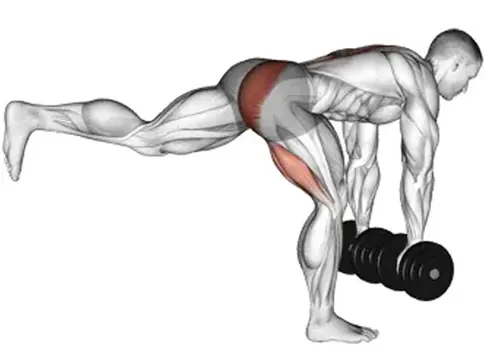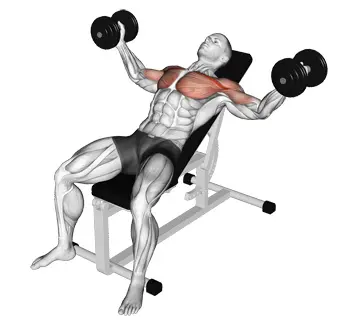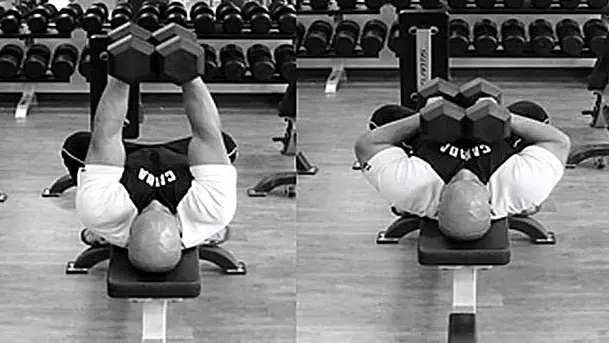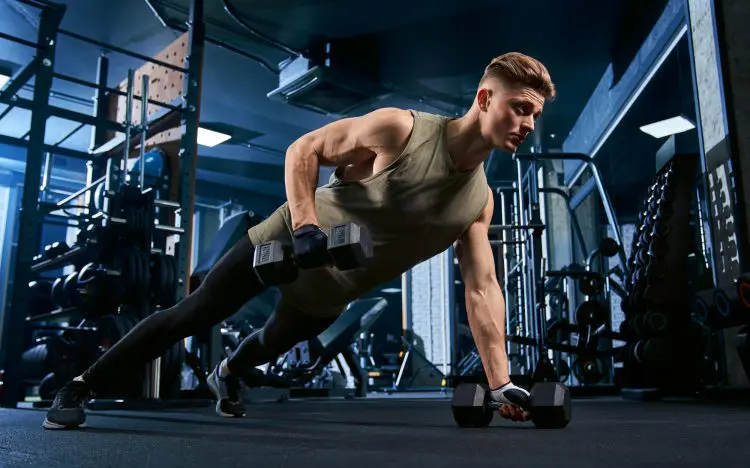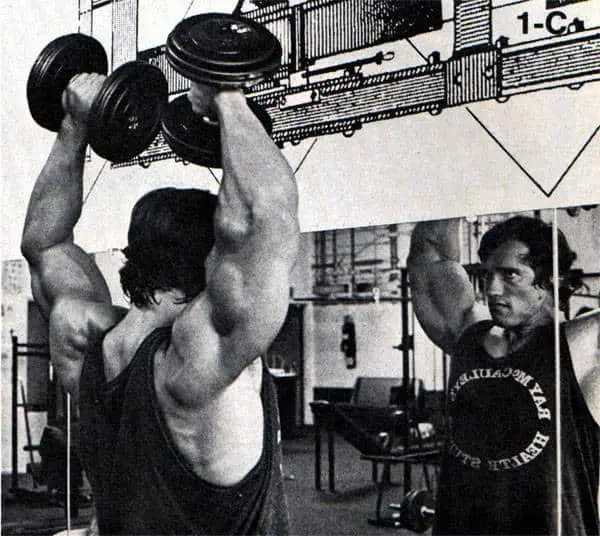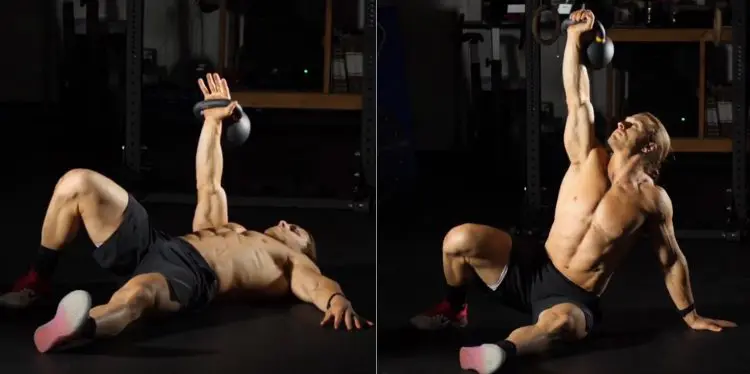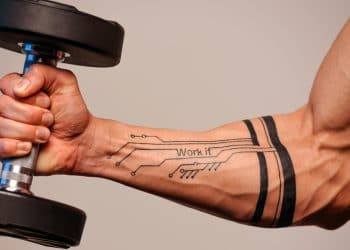There is nothing dumb about dumbbells. In fact, they are one of the most useful training tools in our muscle and strength building toolbox. Training with dumbbells offers several advantages over barbell and resistance machine training, including:
Safety – a failed barbell squat or bench press can have catastrophic results. Getting pinned under a heavy bar is no laughing matter. Performing the same exercises with dumbbells is often much less risky.
Increased range of motion – dumbbells typically allow for a greater range of motion than barbells. Dumbbell bench and shoulder presses are potentially better for hypertrophy than their barbell equivalents and can also help improve your flexibility and joint mobility.
Improved balance and coordination – lifting two dumbbells instead of a single barbell requires and develops greater balance and coordination. Improving these neurological components of fitness will increase athleticism and functionality.
Fix strength imbalances – while it’s normal to have one arm or leg stronger than the other, large discrepancies can cause injuries and postural problems. Training with dumbbells provides a useful way to spot and then fix any such imbalances.
Increased comfort – dumbbells allow you to modify your movements according to your unique morphology, taking stress off your joints. For example, a barbell bench press locks your hands in place, which affects your elbows and shoulders. In contrast, dumbbell bench presses allow you to modify the movement for increased comfort.
Level Up Your Fitness: Join our 💪 strong community in Fitness Volt Newsletter. Get daily inspiration, expert-backed workouts, nutrition tips, the latest in strength sports, and the support you need to reach your goals. Subscribe for free!
Convenience – a standard barbell is seven-feet long. If you train at home, you may not have the space to use or store a barbell. In contrast, dumbbells are much smaller and take up less training and storage space. Armed with nothing more than a pair of adjustable dumbbells and an exercise bench, you can train every muscle in your body.
Read also Barbells vs. Dumbbells: Which is Best?
So, don’t feel short-changed if your home or garage gym consists of nothing more than an exercise bench and a set of adjustable dumbbells. In many ways, training with nothing but dumbbells is actually a big advantage!
Full-Body Dumbbell Home Workout
There are lots of different ways you can plan your workouts, and most bodybuilders tend to gravitate toward split routines. However, for a change of pace, this is a full-body workout.
Using full-body workouts, you can train your muscles as many as three times a week, which is a great way to build muscle and can be useful for blasting through training plateaus. Full-body workouts are also helpful for increased fat burning.
But, before you start, make sure you take a few minutes to warm-up and prepare your muscle and joints for what you are about to do. Jump rope or jog for 5 to 10 minutes, and then do some dynamic flexibility and mobility exercises. Finally, do a couple of light sets of the main exercises in the following workout. Use this as an opportunity to assess how you are feeling and dial in your technique.
| Exercise | Sets | Reps | Recovery | |
| 1 | Goblet Bulgarian split squats | 4 | 6-12 per leg | 60-90 seconds |
| 2 | Single-leg Romanian deadlifts | 4 | 6-12 per leg | 60-90 seconds |
| 3 | Dumbbell leg curls | 4 | 6-12 | 60-90 seconds |
| 4 | Single-leg calf raises | 4 | 6-12 per leg | 60-90 seconds |
| 5 | Incline dumbbell flyes | 3 | 6-12 | 60-90 seconds |
| 6 | Dumbbell squeeze press | 3 | 6-12 | 60-90 seconds |
| 7 | Renegade rows | 3 | 6-12 per arm | 60-90 seconds |
| 8 | Wrestler’s rows | 3 | 6-12 per arm | 60-90 seconds |
| 9 | 4-way dumbbell shoulder complex | 3 | 6-12 per exercise | 60-90 seconds |
| 10 | Zottman curls | 2 | 6-12 | 60-90 seconds |
| 11 | Dumbbell skull crushers | 2 | 6-12 | 60-90 seconds |
| 12 | Turkish get-ups | 2 | 6-12 per side | 60-90 seconds |
Sets, Reps, Recovery Periods, and Progression
The accepted rep range for hypertrophy is 6-12 reps, and that’s what we’ve used for this program. Ideally, you should choose weights that take you to muscular failure within this range. If you can’t do six reps, the weight is too heavy, but it’s too light if you can do more than 12.
But what if you only have access to light weights? Does that mean you should stop your set when you reach 12 reps, even if you aren’t tired?
Ending your set before your muscles are fatigued will make this workout a whole lot less effective. If you only have light weights available, you can make this program harder by:
- Doing more reps
- Doing more sets
- Taking shorter breaks between sets
- Using a slower lifting tempo
- Using blood flow restriction training
Remember, too, that to keep making gains, your workouts need to be progressive. You need to try and work a little harder from one week to the next. If you do the same exercises with the same weights and for the same reps week after week, your progress will soon stall. Look for ways to make your next workout harder to keep those gains coming.
Exercise descriptions and instructions
To get the most from any exercise, you need to do it properly. Using the correct technique will keep the training stress on your muscles while sparing your joints from unnecessary wear and tear. If any of the following exercises are new to you, make sure you practice and master them before using too much weight.
1. Goblet Bulgarian Split Squats
Goblet squats are an excellent total leg exercise. They’re also great for developing your balance and hip mobility. Usually done with just bodyweight or a dumbbell in each hand, for this workout, you’re going to hold a single dumbbell in the “goblet” position in front of your chest.
This position promotes better posture while providing your legs with some much-needed overload.
Learn how to do goblet squats with this in-depth guide.
2. Single-Leg Romanian Deadlifts
Romanian deadlifts are one of the best posterior chain exercises you can do. Because they are a bilateral (two-limbed) exercise, they allow you to lift heavy weights. However, if you’ve only got dumbbells to train with, you may find that you don’t have enough weight for this exercise to be productive.
Single-leg Romanian deadlifts are much more challenging than the regular version, so you won’t need as much weight. Also, because they are a unilateral (single-limbed) exercise, this move is better for your balance and coordination.
Learn how to do single-leg Romanian deadlifts here.
3. Dumbbell Leg Curls
Resistance machine leg curls are a great isolation exercise for your hamstrings and are a staple of most leg building workouts. Training at home with dumbbells means you won’t have access to a seated, lying, and standing leg curl machine, but that doesn’t mean you can’t isolate your hammies.
Dumbbell leg curls are an unusual exercise, but you’ll really feel them working. Just take care to keep your feet and lower legs squeezed tightly together, so you don’t drop your weight!
Check out our guide to discover how to do dumbbell leg curls.
4. Single-leg Calf Raises
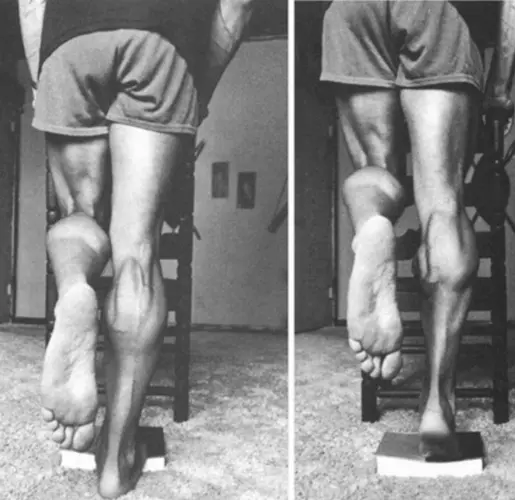
No calf raise machine? No problem! You can still add mass to your lower legs using nothing more than a dumbbell and a step. In fact, before calf raise machines were invented, this was how old-school bodybuilders worked their gastrocnemius and soleus.
The key to this exercise is using a big range of motion. Lower your heel down as far as you can to stretch your calves, and then rise up onto your tiptoes to contract them fully.
Learn how to do single-leg calf raises here.
Level Up Your Fitness: Join our 💪 strong community in Fitness Volt Newsletter. Get daily inspiration, expert-backed workouts, nutrition tips, the latest in strength sports, and the support you need to reach your goals. Subscribe for free!
5. Incline Dumbbell Flyes
Incline dumbbell flyes are an isolation exercise for your upper chest. Doing them before chest presses (your next movement) pre-fatigues your pecs, so the following exercise is more challenging and productive.
There is no need to use a very steeply angled bench. Doing so turns what should be a pec builder into more of a shoulder exercise. Instead, set your bench to about 30-degrees.
Use this guide to make sure you are doing incline dumbbell flyes correctly.
6. Dumbbell Squeeze Press
The dumbbell squeeze press provides a lot of overload for your pecs, even if you don’t have access to heavy weights. They’re also easier on your shoulders than both the barbell and regular dumbbell bench presse.
How to do it:
- Lie on a flat bench with a dumbbell in each hand. Press the weights up to arms’ length and hold them over your chest. Turn your hands so they are facing inward and then press the dumbbells together.
- Maintaining this inward pressure, bend your arms and lower the weights to your sternum.
- Press the dumbbells back up and repeat.
- The harder you press the weights together, the more effective this exercise becomes.
7. Renegade Rows
If you want your back to grow, you’ve got to row! There are lots of different rowing exercises you can use to build your back, but renegade rows are one of the most challenging. You don’t need a lot of weight to get a good renegade row workout, making it ideal for home training. And, as well as being an effective back exercise, renegade rows are also great for your core.
Learn how to master the renegade row with our comprehensive guide.
8. Wrestler’s Rows
Most rowing exercises start with your arms straight. The wrestler’s row is different. For this move, you start with your arms bent, and the weights pulled into your ribs. This increases time under tension and muscle activation. The wrestler’s row is a useful way to get a great back workout, even if you only have light dumbbells.
How to do it:
- Stand with your feet about shoulder-width apart and a dumbbell in each hand. Bend your knees slightly and brace your abs. Hinge forward from your hips and lean over until your upper body is inclined to about 50-70 degrees. Brace your abs and do not round your lower back, as this could lead to back injury.
- Bend your arms and pull the weights up and into the side of your lower ribs. Your hands should face inward toward your body – a neutral grip.
- Keeping one arm bent, extend your other arm and lower the weight down to arms’ length. Bend your arm and pull the weight back up to your ribs.
- Next, extend your other arm and repeat.
- Continue alternating arms for the duration of your set.
9. 4-way Dumbbell Shoulder Complex
The 4-way dumbbell shoulder complex combines four deltoid exercises into one pump-inducing, muscle-building giant set sequence. It hits your deltoids from several different angles to deliver an effective workout in quick double time.
Do each of the following exercises back-to-back, with no rests in between. And yes, that intense burn you can feel is entirely normal!
- Dumbbell lateral raises
- Alternating dumbbell front raise
- Dumbbell armpit row
- Dumbbell overhead press
10. Zottman Curls
Zottman curls are an old-school biceps and forearm exercise named after American strongman George Zottman. Unlike regular dumbbell curls, the Zottman curl hammers your biceps AND your brachioradialis, making them a very useful and efficient arm builder.
Zottman curls are surprisingly challenging, making them ideal for home trainers who only have light weights to work with.
Check out our in-depth guide to this classic exercise.
11. Dumbbell Skull Crushers
Barbell and EZ bar skull crushers are tremendous triceps builders, but if you get them wrong, they can also live up to their name! A failed rep can result in a bash on the head, and that’s something we all want to avoid.
Dumbbell skull crushers are safer and also increase your range of motion, making them more effective too. Many lifters also find this variation more elbow-friendly.
Make dumbbell skull crushers more effective by doing them on a slight decline. This increases the activation of the long head of the triceps.
Learn how to do dumbbell skull crushers here.
12. Turkish Get-ups
The last exercise in our full-body dumbbell home workout is the Turkish get-up. While no one is exactly sure where this move got its name, we do know it’s a kick-ass core exercise that also works many other muscle groups.
The Turkish get-up is a strength exercise that will also improve your balance, stability, mobility, and agility. In short, it’s a VERY beneficial exercise.
The get-up is certainly not the easiest exercise to learn but mastering it will have a massive impact on how you look, feel, and perform.
Learn how to do the Turkish get-up in this detailed guide.
Wrapping Up
Training with nothing but dumbbells can seem very limiting, but it doesn’t have to be. In fact, even if you train at home, you can use a pair of dumbbells and an exercise bench to work virtually every muscle in your body, increasing both size and strength.
Is training with just dumbbells ideal? Probably not. But, if that’s all you’ve got, you can still achieve great things if you train hard and consistently.
No weight bench? Don’t worry; you can perform exercises like dumbbell squeeze presses, dumbbell leg curls, and even dumbbells flyes on the floor.

